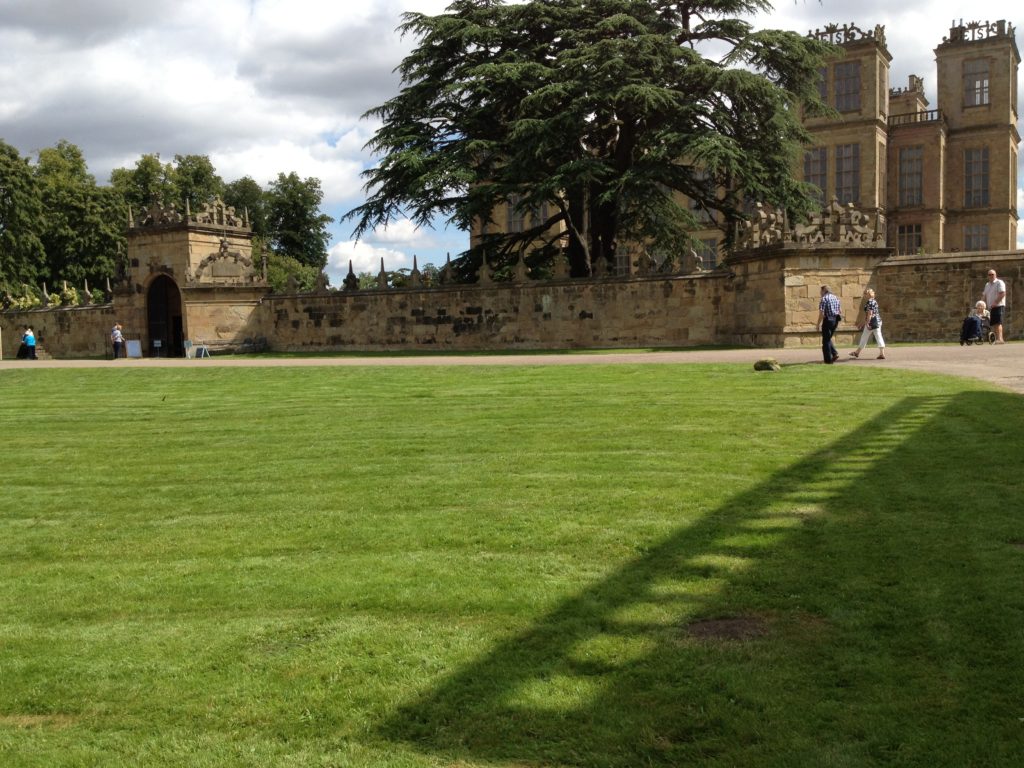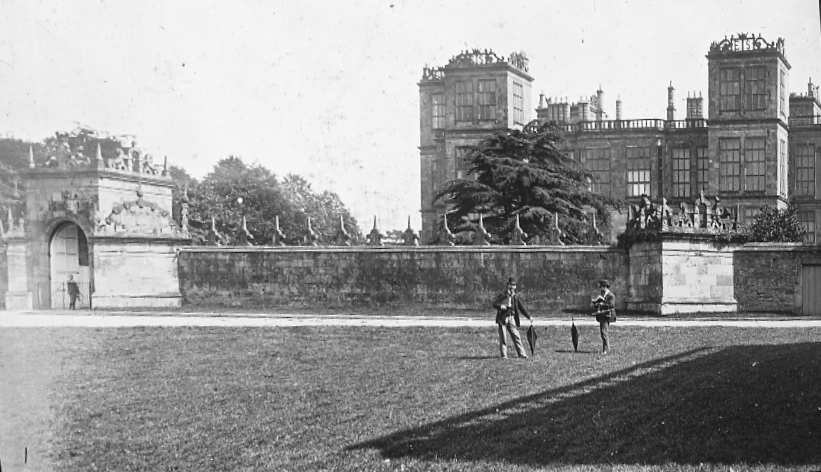I took a photo in August 2012 with a telephone camera whose depth of field and field of view are neither much different to those obtained by whatever device was used by one of my great-grandfathers in July 1888. We’ll call him JLR because it’s easier than John Loftus Robinson. This shot was taken when visiting Hardwick Hall with my father FRR on an excursion following ancestral footsteps documented by a series of photos taken by JLR between 1880 and 1893.
And while we’re abbreviating, so you don’t get confused between JLR, FRR and SLR, I’ll say that SLR is a standard acronym for the single lens reflex camera.
2012: iPhone 4S 2.28mm f/2.4 1284/s ISO60 © Simon Robinson
1888: unknown camera by John L Robinson ARHA 1888 held in RSAI
Hardwick Hall may look familiar to you as Malfoy Manor in Harry Potter and the Deathly Hallow (2010/2011). It’s a so-called prodigy house, an old term for an overblown, showy house. It was among the first built in the 1590s after it had become illegal to fortify domestic dwellings. It is very showy, using egregious quantities of luxury glazing, mocked with the couplet ‘Hardwick Hall, more glass than wall.’
Glass was the basis of the plates in early photography. I think the practical use of the camera became possible for JLR and people like him because of the invention in 1871 of the gelatin coated, dry plate, silver-bromide process. This chemistry meant the development of exposed plates could be postponed to a more convenient time and place. Better still, the plates could be mass produced which democratised photography as is evident in the membership numbers of camera clubs and societies.
JLR died prematurely in 1894 before celluloid was patented (1898) and before the arrival of the Brownie (1900). So he had to use a cumbersome tripod camera and, of course, carry the weighty glass plates to each of his locations. This was how he documented his many interests and many of the photos and plates still exist in the RSAI and a few other places too.
One of these interests was decidedly professional. He was an architect and it seems that he used the camera from about 1880 to augment if not replace his architectural sketching.
I wonder many things about JLR and his photography. Sharing some of his genes, I suspect he was very excited by the marvels of cameras. It’s not a coincidence that four generations following him have each had very keen photographers. And a girl in the fifth generation recently asked for a camera for her sixth birthday.
I have wondered if JLR could have known that George Eastman was inventing flexible paper based film (1881) and patenting his Kodak (1888) around the same time that JLR was carrying his huge camera around. Was he hoping to be able to avail of emerging technologies as we do now? Or was he simply so pleased to have the technology, albeit cumbersome, that he just got on with it. I’ve seen enough of his photos to suspect he had a helper, probably very useful for schlepping the glass plates.
An irony is that I still carry a huge SLR camera, often on a tripod, often ignoring the excellent camera on the smartphone, relegating the smartphone to location tracking, natural light planning and exposure calculations. Camera technology is all about improving the the signal to noise ratio and in the digital era, there’s no substitute for huge photosites, powerful image processors matched with low-dispersion, flouride glass in the lenses. By example, the surface area of each photosite on my Canon 1D-X sensor is approx. 24 times bigger than those on my Apple iPhone 11. More photons will hit each photosite on the 1D-X meaning that it gathers more light (signal) and is far better as a low-light camera. It’s this so-called photon ‘shot’ noise that determines the quality of the image.
I’ve also been using a mirrorless Fujifilm X-T3 for two years. It’s considerably easier to carry than the Canon SLR, indeed it generally dangles on a strap secured around my wrist. And as good as it is, it’s not quite as good as the Canon in the most challenging lights because the photosite area of the Canon is 2.4 time bigger than the X-T3.
And once you can rely on the signal to noise ratio, the camera technology becomes almost autonomic, like breathing, freeing the holder to compose and capture those ‘decisive moments’ that Cartier-Bresson so liked or plan to capture great landscapes like Ansel Adams.
And to close, I think the confusions of photography are beautifully conveyed by this quote from Ansel Adams:
‘I can get — for me — a far greater sense of ‘colour’ through a well-planned and executed black-and-white image than I have ever achieved with colour photography.’



Leave a Reply